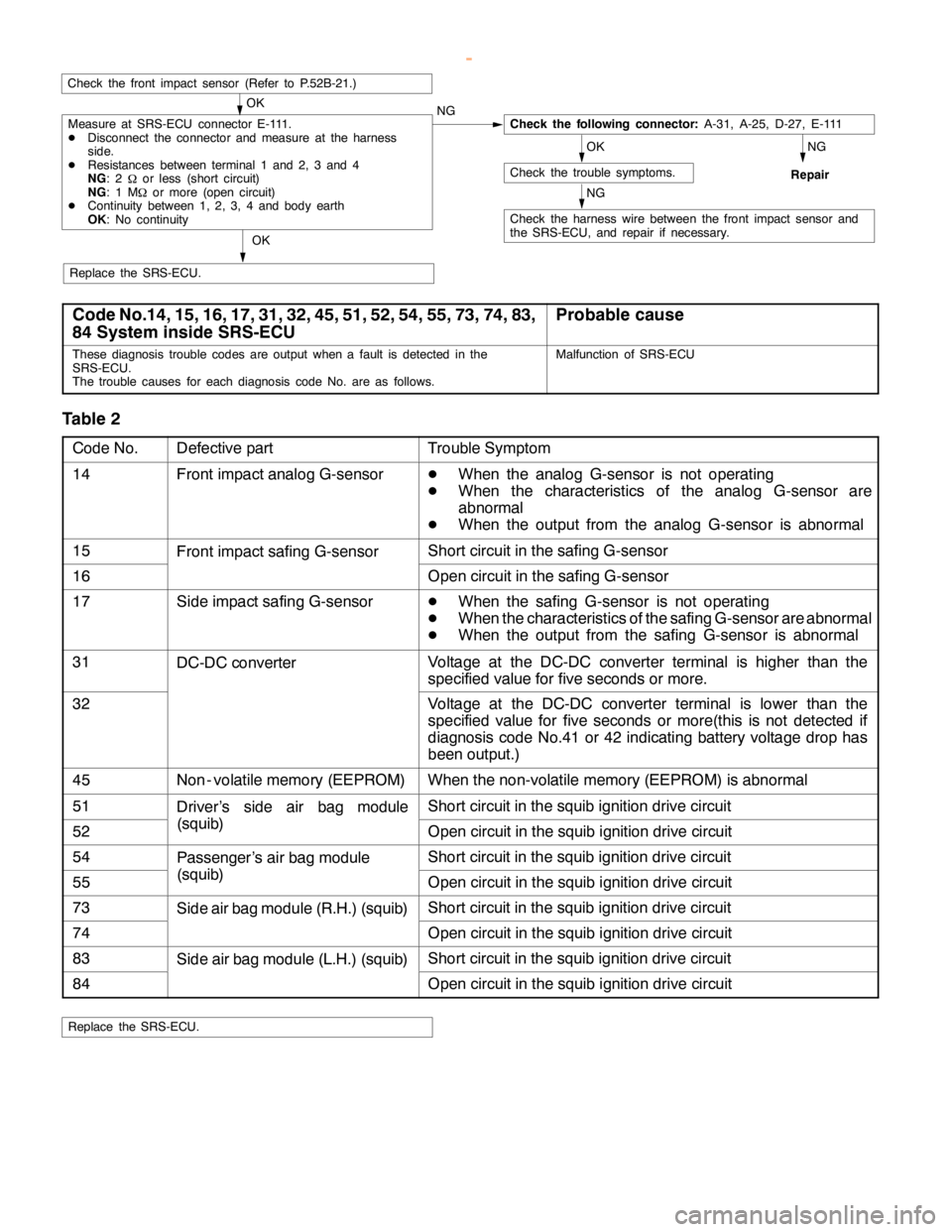2000 MITSUBISHI MONTERO ECU
[x] Cancel search: ECUPage 1285 of 1839

ABS <4WD> -Troubleshooting35B-22
DATA LIST REFERENCE TABLE
The following ECU input data items can be read using the MUT-II
.
(1) When system is normal
Item
No.Check itemInspection conditionsNormal condi-
tion
11Front - right wheel
speedWhen vehicle is being drivenSpeedometer
display and
12Front - left wheel
speedMUT-IIdisplay
are identical.
13Rear - right wheel
speed
14Rear - left wheel
speed
16System voltageIgnition switch: ON6.5 - 22.3 V
26Center differential
lock switchIgnition switch: ONTransfer selector lever position:
2H, 4HOFF
Transfer selector lever position:
4HLc, 4LLcON
27Rear differential lock
switchIgnition switch: ONOFF
32G sensorD
Ignition switch: ON
D
When vehicle is stationary (level)2.4 - 2.6 V
When vehicle is being driven1.0 - 4.0 V
33Stop lampIgnition switch: ONWhen brake pedal is depressedON
SwitchWhen brake pedal is releasedOFF
(2) When system is interrupted by the ECU
When the diagnosis function has caused the operation of the ABS-ECU to be stopped, the
MUT-II
display data may be different from the actual condition.
ACTUATOR TEST TABLE
The following actuators can be force-driven using the MUT-II
.
NOTE
(1) Actuator tests cannot be carried out when the operation of the ABS-ECU has been stopped by
the fail-safe function.
(2) Actuator tests can only be carried out while the vehicle is stopped.
ACTUATOR TEST SPECIFICATIONS
Item No.Check itemDrive Contents
01FR wheel solenoid valveHBB select solenoid valves and control solenoid valves for the
02FL wheel solenoid valverespective channel
03RR wheel solenoid valve
04RL wheel solenoid valve
27Air bleeding (1)HBB select solenoid valves and control solenoid valve OUT (FR, FL)
28Air bleeding (2)HBB control solenoid valve OUT (RR, RL)
www.WorkshopManuals.co.uk
Purchased from www.WorkshopManuals.co.uk
Page 1294 of 1839

ABS <4WD> -On-vehicle Service35B-31
WHEN THE BATTERY IS FLAT
If the engine is started using a booster cable when the battery
is completely flat, and the vehicle is then driven without waiting
for the battery to be recharged, the engine may misfire and it
may not be possible to drive the vehicle. This is because the
ABS consumes a large amount of current when carrying out its
initial checks. If this happens, recharge the battery fully.
Caution
The vehicle posture will be unstable during braking, so
do not drive the vehicle with the ABS-ECU connector
disconnected or with the ABS not operating for any other
reason.
www.WorkshopManuals.co.uk
Purchased from www.WorkshopManuals.co.uk
Page 1310 of 1839

37A-1
STEERING
CONTENTS
GENERAL INFORMATION 2..................
SERVICE SPECIFICATIONS 5.................
LUBRICANTS 5..............................
SEALANT AND ADHESIVE 5.................
SPECIAL TOOLS 6..........................
ON-VEHICLE SERVICE 8.....................
Steering Wheel Free Play Check 8..............
Steering Angle Check 8........................
Tie Rod End Ball Joint Starting Torque Check 8..
Stationary Steering Effort Check 9...............
Steering Wheel Returnability Check 9............
Oil Pump Belt Tension Check <6G7,4D5> 9......Power Steering Fluid Level Check 10............
Power Steering Fluid Replacement 10...........
Power Steering System Bleeding 10.............
Oil Pump Pressure Test 11.....................
Power Steering Oil Pressure Switch Check
<6G7,4M4> 12.................................
Ball Joint Dust Cover Check 12.................
STEERING WHEEL AND SHAFT* 13.........
POWER STEERING GEAR BOX AND
LINKAGE 16................................
POWER STEERING OIL PUMP 30...........
POWER STEERING OIL HOSES 35..........
WARNINGS REGARDING SERVICING OF SUPPLEMENTAL RESTRAINT SYSTEM (SRS) EQUIPPED VEHICLES
WARNING!
(1) Improper service or maintenance of any component of the SRS, or any SRS-related component, can lead to personal
injury or death to service personnel (from inadvertent firing of the air bag) or to the driver and passenger (from rendering
the SRS inoperative).
(2) Service or maintenance of any SRS component or SRS-related component must be performed only at an authorized
MITSUBISHI dealer.
(3) MITSUBISHI dealer personnel must thoroughly review this manual, and especially its GROUP 52B - Supplemental
Restraint System (SRS) before beginning any service or maintenance of any component of the SRS or any SRS-related
component.
NOTE
The SRS includes the following components: SRS-ECU, SRS warning lamp, air bag module, clock spring and interconnecting
wiring. Other SRS-related components (that mayhave to be removed/installed in connectionwith SRS service or maintenance) are
indicated in the table of contents by an asterisk(*).
www.WorkshopManuals.co.uk
Purchased from www.WorkshopManuals.co.uk
Page 1402 of 1839

BODY -SunroofBODY -Sunroof42-50
"
BA
SUNROOF MOTOR ASSEMBLY INSTALLATION
1. Install the roof lid glass assembly and the sunroof motor
assembly with the sunroof motor assembly in the
fully-closed position.
2. Connect the sunroof motor assembly harness connector
and the sunroof switch harness connector to the vehicle
wiring harness connector.
3. Operate the sunroof and check that it operates correctly.
1. Install the roof lid glass assembly and the sunroof motor
assembly with the sunroof motor assembly in the
fully-closed position.
2. Connect the sunroof motor assembly harness connector
and the sunroof switch harness connector to the vehicle
wiring harness connector.
3. Operate the sunroof switch to slide the roof lid glass
to the fully-open position, and then tilt it up in steps of
30 mm to the fully-open position and then keep pressing
the switch for 3 seconds or more.
4. Operate the sunroof switch (CLOSE) using the one-touch
function to slide the roof lid glass to the fully-closed
position.
5. Operate the sunroof switch (OPEN) using the one-touch
function to slide the roof lid glass to the fully-open position.
6. Operate the sunroof switch (CLOSE) using the one-touch
function to slide the roof lid glass to the fully-closed
position.
7. Press the tilt - up switch to operate the sunroof and check
that learning is complete.
NOTE
(1) During initialisation (learning mode), use only the
CLOSE/DOWN switch to move the roof lid glass from
the fully-closed position to the fully tilted open position.
During initialisation, the TILT UP switch will not work
when pressed. Furthermore, the sunroof-ECU will stop
running in learning mode as soon as the roof lid glass
is tilted up.
(2) When the clamping prevention mechanism is
cancelled, the operation is the same as when the
roof lid glass operates 30 mm at a time.
www.WorkshopManuals.co.uk
Purchased from www.WorkshopManuals.co.uk
Page 1457 of 1839

52A-2
INTERIOR
CONTENTS
SERVICE SPECIFICATIONS 3.................
SPECIAL TOOL 3............................
INSTRUMENT PANEL
INSTRUMENT PANEL
FLOOR CONSOLE 12........................
TRIMS 13...................................
SUNVISOR HOLDER 17......................FRONT SEAT 18............................
REAR/SECOND SEAT 25....................
THIRD SEAT 35.............................
FRONT SEAT BELT 38.......................
REAR SEAT BELT
SECOND/THIRD SEAT BELT
WARNINGS REGARDING SERVICING OF SUPPLEMENTAL RESTRAINT SYSTEM (SRS) EQUIPPED VEHICLES
WARNING!
(1) Improper service or maintenance of any component of the SRS, or any SRS-related component, can lead to personal
injury or death to service personnel (from inadvertent firing of the air bag) or to the driver (from rendering the SRS
inoperative).
(2) Service or maintenance of any SRS component or SRS-related component must be performed only at an authorized
MITSUBISHI dealer.
(3) MITSUBISHI dealer personnel must thoroughly review this manual, and especially its GROUP 52B - Supplemental
Restraint System (SRS) before beginning any service or maintenance of any component of the SRS or any SRS-related
component.
NOTE
The SRS includes the following components: front impact sensors, SRS-ECU, SRS warning lamp, air bag module, clock spring and
interconnecting wiring. Other SRS-related components (that mayhave to be removed/installed in connectionwith SRS service or
maintenance) are indicated in the table of contents by an asterisk(*).
www.WorkshopManuals.co.uk
Purchased from www.WorkshopManuals.co.uk
Page 1501 of 1839

52B-1
SUPPLEMENTAL
RESTRAINT
SYSTEM (SRS)
CONTENTS
GENERAL INFORMATION 2..................
SRS SERVICE PRECAUTIONS 3..............
SPECIAL TOOLS 5..........................
TEST EQUIPMENT 6.........................
TROUBLESHOOTING 7.......................
SRS MAINTENANCE 19.....................
POST-COLLISION DIAGNOSIS 23............
INDIVIDUAL COMPONENT SERVICE 26......
WARNING/CAUTION LABELS 27.............FRONT IMPACT SENSORS 28...............
SRS AIR BAG CONTROL UNIT
(SRS-ECU) 30...............................
AIR BAG MODULES AND CLOCK
SPRING 32.................................
SIDE IMPACT SENSOR 41..................
AIR BAG MODULE DISPOSAL
PROCEDURES 43...........................
Undeployed Air Bag Module Disposal 43.........
Deployed Air Bag Module Disposal
Procedures 52.................................
CAUTION
DCarefully read and observe the information in the SERVICE PRECAUTIONS (P.52B-3.) prior to any service.
DFor information concerning troubleshooting or maintenance, always observe the procedures in the Troubleshooting
(P.52B-7.) section.
DIf any SRS components are removed or replaced in connection with any service procedures, be sure to follow the
procedures in the INDIVIDUAL COMPONENT SERVICE section (P.52B-26.) for the components involved.
DIf you have any questions about theSRS, please contact your local distributor.
www.WorkshopManuals.co.uk
Purchased from www.WorkshopManuals.co.uk
Page 1508 of 1839

SRS -Troubleshooting52B-8
Code No.Reference
page Diagnosis item
43*1SRS warning lamp drive circuit systemLamp does not illuminate.52B-14
Lamp does not go out off.52B-14
44*1SRS warning lamp drive circuit system52B-14
45Internal circuit system of non-volatile memory (EEPROM) inside SRS-ECU52B-9
51, 52Driver’s air bag module (squib) system52B-9
54, 55Passenger’s air bag module (squib) system52B-9
71*2,72*2, 75, 76Side air bag module (R.H.) (squib) system52B-15
73, 74Side air bag module (R.H.) (squib) system52B-9
79, 93Side impact sensor (L.H.) communication system52B-16
81*2,82*2, 85, 86Side air bag module (L.H.) (squib) system52B-16
83, 84Side air bag module (L.H.) (squib ignition drive circuit) system52B-9
89, 96Side impact sensor (R.H.) communication system52B-17
91*1Side impact sensor (L.H.) power supply circuit system52B-17
92Analog G-sensor system inside side impact sensor52B-17
94*1Side impact sensor (R.H.) power supply circuit52B-18
95Analog G-sensor system inside side impact sensor (R.H.)52B-17
NOTE
1. *1: If the trouble(s) are extinguished, the SRS warning lamp will go out with diagnosis code history
automatically erased.
2. *2: If the vehicle condition return to normal, the diagnosis code will be automatically erased, and
the SRS warning lamp will return to normal.
3. If the vehicle has a discharged battery, it will store the fault codes 41 or 42. When these diagnosis
codes are displayed, check the battery.
INSPECTION PROCEDURE CLASSIFIED BY DIAGNOSIS CODE
Code No.11, 12 or 13 Front impact sensor systemProbable cause
These diagnosis codes are output if there is abnormal resistance between the
input terminals of the front impact sensors inside the SRS-ECU.
The trouble causes for each diagnosis code No. are as follow.DMalfunction of harness or connector
DMalfunction of front impact sensor
DMalfunction of SRS-ECU
Table 1
Code No.Trouble Symptom
11D
Short circuit in front impact sensor or harness
D
Short circuit in front impact sensor harness leading to the vehicle body ground
D
Short circuit in front impact sensor harness leading to the power supply
12D
Open circuit in either left or right front impact sensor or harness
D
Short circuit in front impact sensor harness leading to the power supply
13D
Open circuit in both left and right front impact sensor or harness
D
Short circuit in front impact sensor harness leading to the power supply
www.WorkshopManuals.co.uk
Purchased from www.WorkshopManuals.co.uk
Page 1509 of 1839

SRS -Troubleshooting52B-9
OK
Check the trouble symptoms.
NG
Repair
OK
Replace the SRS-ECU.
Measure at SRS-ECU connector E-111.
DDisconnect the connector and measure at the harness
side.
DResistances between terminal 1 and 2, 3 and 4
NG:2
Wor less (short circuit)
NG:1M
Wor more (open circuit)
DContinuity between 1, 2, 3, 4 and body earth
OK: No continuityNGCheck the following connector:A-31, A-25, D-27, E-111
NG
Check the harness wire between the front impact sensor and
the SRS-ECU, and repair if necessary.
OK
Check the front impact sensor (Refer to P.52B-21.)
Code No.14, 15, 16, 17, 31, 32, 45, 51, 52, 54, 55, 73, 74, 83,
84 System inside SRS-ECUProbable cause
These diagnosis trouble codes are output when a fault is detected in the
SRS-ECU.
The trouble causes for each diagnosis code No. are as follows.Malfunction of SRS-ECU
Table 2
Code No.Defective partTrouble Symptom
14Front impact analog G-sensorD
When the analog G-sensor is not operating
D
When the characteristics of the analog G-sensor are
abnormal
D
When the output from the analog G-sensor is abnormal
15Front impact safing G-sensorShort circuit in the safing G-sensor
16Open circuit in the safing G-sensor
17Side impact safing G-sensorD
When the safing G-sensor is not operating
D
When the characteristics of the safing G-sensor are abnormal
D
When the output from the safing G-sensor is abnormal
31DC-DC converterVoltage at the DC-DC converter terminal is higher than the
specified value for five seconds or more.
32Voltage at the DC-DC converter terminal is lower than the
specified value for five seconds or more(this is not detected if
diagnosis code No.41 or 42 indicating battery voltage drop has
been output.)
45Non - volatile memory (EEPROM)When the non-volatile memory (EEPROM) is abnormal
51Driver’s side air bag moduleShort circuit in the squib ignition drive circuit
52(squib)Open circuit in the squib ignition drive circuit
54Passenger’s air bag moduleShort circuit in the squib ignition drive circuit
55(squib)Open circuit in the squib ignition drive circuit
73Side air bag module (R.H.) (squib)Short circuit in the squib ignition drive circuit
74Open circuit in the squib ignition drive circuit
83Side air bag module (L.H.) (squib)Short circuit in the squib ignition drive circuit
84Open circuit in the squib ignition drive circuit
Replace the SRS-ECU.
www.WorkshopManuals.co.uk
Purchased from www.WorkshopManuals.co.uk